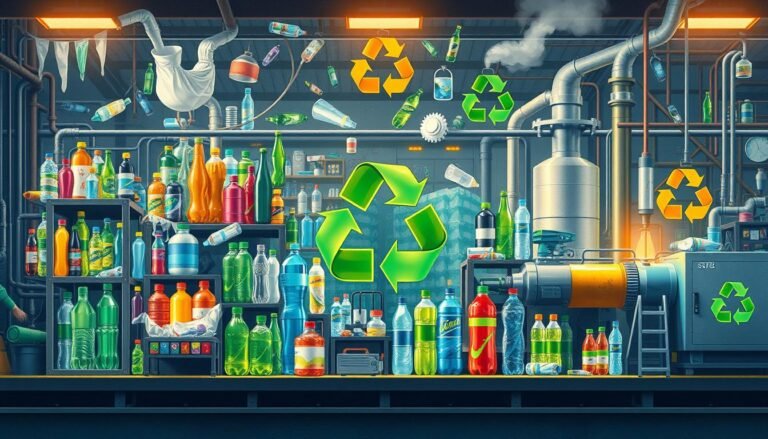Apportare alcune modifiche all'ambiente mondiale
-
Edificio 3, Wanyang Innovation City, Langxia Street, Yuyao City, provincia di Zhejiang
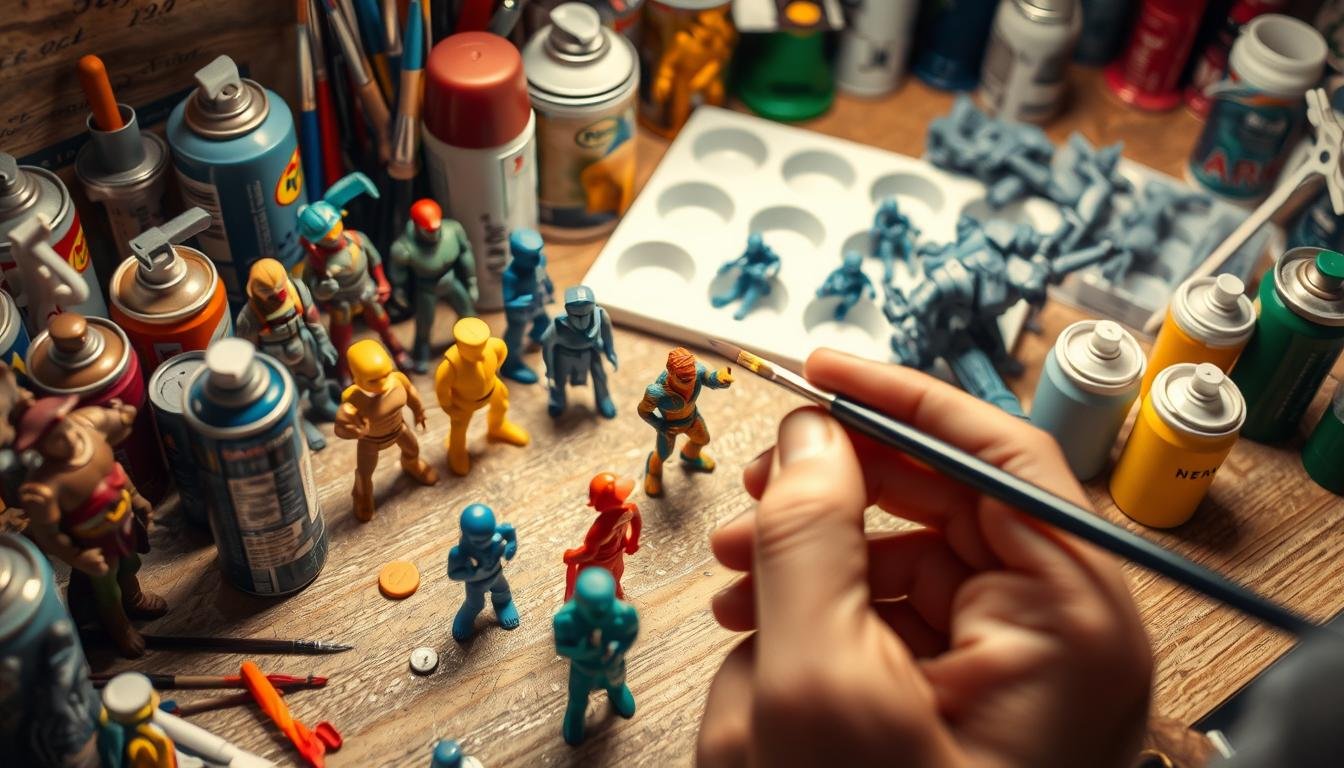
Guida alla verniciatura: Come dipingere la plastica in modo efficace
Ever wonder why painting plastic is tough compared to other materials? Painting plastic does more than just make things look nice. It also protects your items from damage and the weather. Whether you’re updating an old plastic lawn chair or coloring a kid’s toy, the right prep and materials are key. Our detailed guide covers everything needed for pro-like results. We’ll show you how to pick the proper paint and apply it correctly. Follow this guide to give your plastic items a great new look.
Punti di forza
- Painting plastic extends item lifespan and protects against elements.
- Proper surface preparation is crucial for durable results.
- Use fine sandpaper between 180 to 220 grit for sanding plastic surfaces before painting12.
- Cleaner surfaces enhance paint adhesion—use mineral spirits or isopropyl alcohol12.
- Specialized spray paints like Krylon Fusion or Rust-Oleum are recommended for best results2.
- Spray painting techniques and primer applications will be essential parts of the painting process.
Understanding the Challenges of Painting Plastic
Painting plastic surfaces is not easy. This is because plastic is very smooth and does not soak up paint like wood does. Also, plastic changes size with temperature, leading to paint that cracks or flakes off. Knowing these challenges helps in successfully painting on plastic.
Why Plastic Surfaces are Difficult to Paint
One main challenge with painting plastic is its low surface energy. This affects how well paint sticks, especially on materials like polyethylene and polypropylene3. Paint struggles to cover and stick to complex or three-dimensional plastic shapes3. Also, humidity can change how well paint goes on. Keeping humidity at 50 percent in paint booths helps reduce static on plastic parts and improves how well paint is applied4. The variety of plastics and paints makes achieving a long-lasting finish tough3.
Common Issues: Cracking and Flaking
Plastics’ flexibility means paint may crack or flake when the plastic expands or contracts. This is why tests to check if the paint will stick well, like peel tests (ASTM D3359) and pull-off tests (ASTM D4541), are important5. Paint can also affect the plastic’s strength and ability to stretch without breaking. So, it’s essential to test thoroughly to ensure the paint and plastic work well together5. This shows painting plastic needs careful prep and high-quality materials.
guidance on optimizing extruder performance
Materials and Tools Needed for Painting Plastic
To get great results when painting plastic, you need the right materials and tools. We’ll talk about what tools and paint you should use for a smooth, lasting finish.
Strumenti essenziali per il lavoro
Before you start, make sure you have these tools ready:
- Fine-grit sandpaper: Use 200 grit sandpaper to roughen the surface for better paint stickiness6. For a smoother surface, 220 grit works well too6.
- Scrub brush: Needed to clean the plastic, especially if there’s mildew. A mix of water and bleach (3:1) is good for scrubbing6.
- Rags and Suitable Cleaners: To clean the surface after sanding and scrubbing, use mineral spirits or isopropyl alcohol.
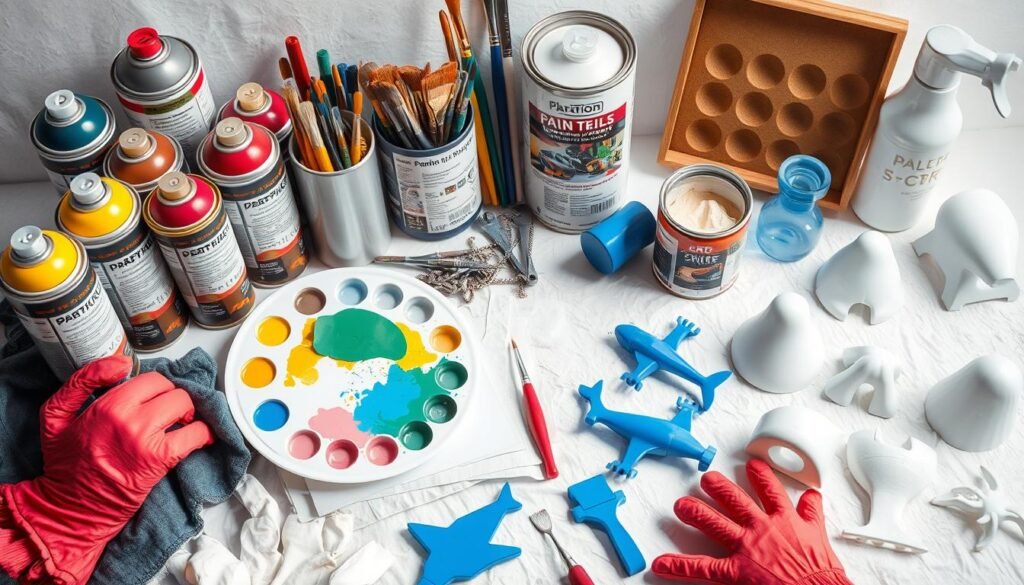
Don’t forget to work in a place with good air flow. And wear gloves and masks to stay safe.
Recommended Types of Paint for Plastic
Picking the right paint is key for a good look and long-lasting finish. Here are our top picks:
- Acrylic Spray Paint: Great for indoors, it makes the surface smooth and is easy to use6. Most people like spray paint because it goes on evenly7.
- Plastic-Specific Spray Paint: Made for outdoor use, these paints stick really well to smooth plastics7.
- PVC Acrylic Latex Primer: Perfect for outside PVC, it helps the paint stick better6.
- High-Adhesion Latex Stain-Blocking Primer: Use this inside to keep stains away and help paint stick6.
- 100-Percent Acrylic Latex Paint: When painting plastic, use a top-quality brush for the best look6.
How you paint is really important. Be sure to spray light layers, keep the can straight, and avoid drips for the top look6. Also, letting the paint dry and cure well is a must for the paint to last and stick almost perfectly7.
Prepping Your Workspace for Plastic Painting
Getting your painting area ready is key for top-notch results and keeping safe. Each spot, whether inside or outside, has its own things to think about. It’s important to tackle these areas well.
How to Set Up an Outdoor Workspace
Pick a spot outside that’s protected from the wind to keep dust away from your work. Use cardboard or plastic tarps to cover the ground. Follow the temperature guide on your paint can for the best stick and quick drying. Keep your tools and paint close by to work smoothly.
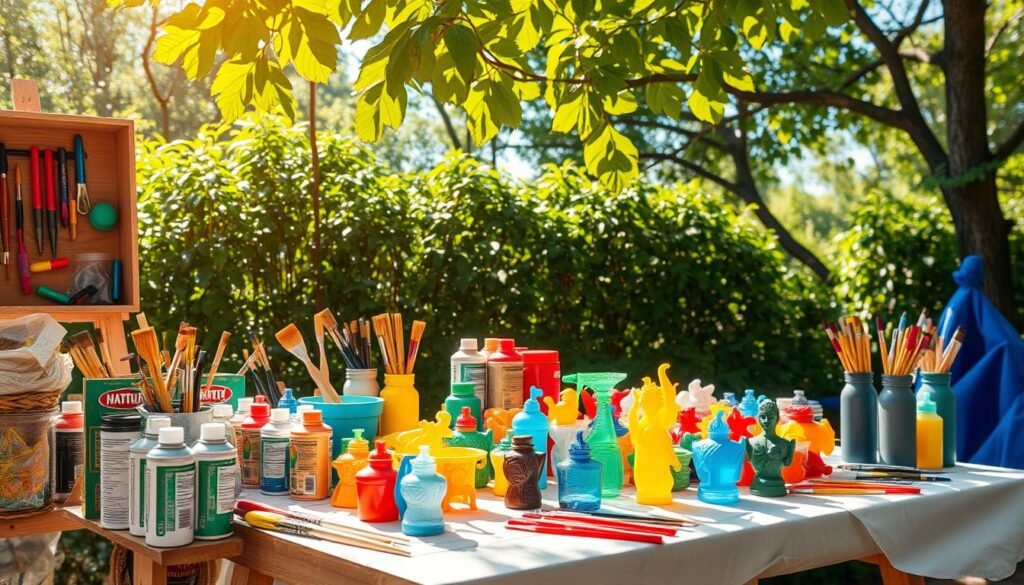
When painting plastic outside, watch out for the weather. Using the right spray paint, like Krylon Fusion for Plastic® or Valspar® Plastic Spray Paint8, is key. Apply a few light coats for a nice finish9.
Indoor Setup Considerations
Good air flow is a must for indoor painting. Use fans by windows or doors to move air and get rid of fumes. Cover everything around you with cloths or sheets to protect from paint drops. Tape off parts you don’t want painted for sharp edges9.
Getting ready to paint indoors means making things safe and tidy. Clean your plastic with soap and water, then alcohol to remove oil8. Test your paint on cardboard first. This way, you’ll get the perfect layer on your actual piece9.
For tips on a pro finish, check out our full guide on PVC recycling processes. It has more advice on preparing plastics for painting8.
How to Paint Plastic: Step-by-Step Guide
Painting plastic is rewarding if you do it right. Our step-by-step guide shows top techniques for painting plastics. Follow our tips to get a long-lasting, professional look.
Step One: Cleaning the Plastic Surface
Start by cleaning the plastic to get rid of dirt, grease, or old paint. Warm water and mild dish soap work well for cleaning10. It’s key to remove all grime so the paint sticks. You can also use cleaning products or mix water with a little bleach11.
Step Two: Sanding for Better Adhesion
Now, sand the plastic. Use 220 to 300-grit sandpaper to lightly texturize the surface10. Sanding helps the primer and paint stick, avoiding peels. Clean it with rubbing alcohol to remove dust after sanding10.
Step Three: Applying Primer to Plastic
Using a plastic-specific primer is crucial. It smooths the surface and preps it for painting. We suggest a Krylon Fusion All-In-One® primer, which simplifies the process12. Let the primer dry completely before the next step.
Step Four: Spray Painting Techniques
For spray painting, use steady, sweeping movements. Hold the spray can 8-12 inches from the surface to prevent drips12. Krylon Fusion All-In-One® dries in 20 minutes and cures in an hour12. Wait a bit between coats for the best result12. We recommend Krylon’s COLORmaxx and Fusion for a sleek finish11. Here’s a quick outline of the process:
- Clean the surface well.
- Sand with 220 to 300-grit sandpaper.
- Apply primer and let it dry fully.
- Paint with sweeping sprays from a distance.
- Pause briefly between light coats.
- Wait for the paint to dry before handling.
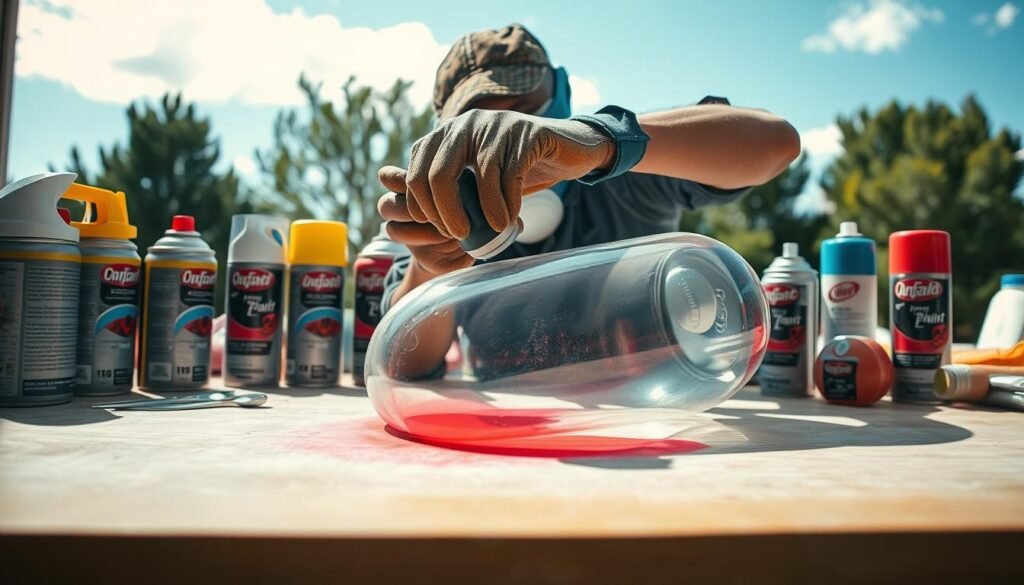
With this guide, your plastic painting project can look awesome and last long. The right methods and products are key to a great finish.
Choosing the Best Paint for Plastic
When you want to paint plastic, picking the right paint is key for a long-lasting, good-looking finish. There are many paints made just for plastic. Multi-surface paints and plastic spray paints work best because they stick well and last long. Rust-Oleum Painter’s Touch Ultra Cover spray paint is a good choice. It costs $4 to $6 per can. You can also buy six-packs to save money13.
For custom colors, NAPA makes DIY paint that matches car exteriors, including plastic parts. It costs about $35 for a 16-oz. can13. Testors enamel model paints are cheaper, at $2 to $4 per one-half oz. bottle. They even have themed kits for less than $2013. Remember, preparing the surface well by cleaning and sanding is very important. This helps avoid paint drips and a rough finish, as 40% of our readers have mentioned10.
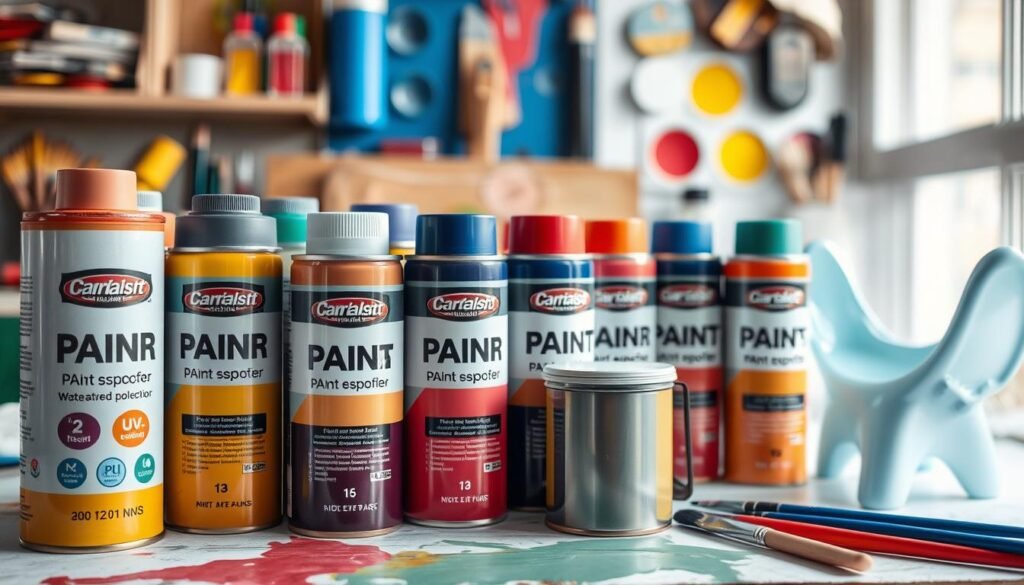
A good primer makes a big difference too. Rust-Oleum Specialty Plastic Primer costs $17 to $30 for a 32-oz. can. Menards has it for about $15, which is a great deal13. Using the right primer makes the paint stick better and look smoother. This is especially true for plastic tubs, which need special primers as 75% of users suggest10.
How you apply the paint is also important. Use a sprayer for big or complex items and a brush for small, detailed parts. Multi-surface paints are popular because they’re easy to use. They don’t need a primer and only require two coats14.
Choosing the correct paint and prepping well means your painted plastic will look great and last a long time. For more tips on the best paint for plastic, check out questa guida14.
Painting Techniques for Different Plastic Items
Different plastic items need unique painting approaches for the best look and durability. Knowing how to paint small and large plastic items can make a big difference.
Painting Small Plastic Items
Small plastic pieces need careful attention. Fine brushes help with detailed work. To make sure paint sticks well, clean the item first. This could mean washing it with power and then wiping with a solvent. This gets rid of oil and dirt15. A good clean helps prevent paint problems like popping.
Painting Large Plastic Surfaces
Spray painting is great for big plastic items because it’s quick and covers well. Always use a primer first to stop colors from fading and to make paint stick better16. Try spinning items on a lazy Susan for a smooth coat. Doing some test sprays can help you get better16. For plastics with fibers showing through, use a special primer to block solvents15.
Using Brushes vs. Spray Paints
Whether to use brushes or spray paints depends on your project. Brushes are best for small jobs that need detail. Spray painting is quicker for larger areas. Both ways need you to prepare the surface well. Testing if a plastic is ready for paint can help15. Using sealants like polycrylic or polyurethane can protect your work. Polyurethane is even good for outdoors17.
To make plastic recycling machines that last, knowing these painting tips is key. They help projects succeed and are good for the planet. For more about preparing plastic and recycling, check out our guide on the importance of plastic recycling15.
Outdoor Plastic Painting Tips
When painting plastic items outdoors, you must think about several things to get a lasting and good-looking finish. Both the weather and how you take care of the plastic affect how durable and nice it looks.
Weather Considerations
The weather greatly influences how well your outdoor plastic painting project turns out. It’s best to paint when the temperature is moderate, ideally between 50°F and 75°F. Also, paint when humidity is low for the paint to dry and stick well. Don’t paint when it’s very hot or very cold, and make sure the plastic is dry before starting. Since plastic is smooth and doesn’t soak things up, it can crack or peel over time. This happens more when the temperature and moisture change a lot61.
Maintenance for Outdoor Painted Plastic
Keeping painted plastic looking good helps it last longer. It’s important to clean it regularly with a gentle soap and water. This gets rid of dirt without hurting the paint. You should also check often for damage or wear and fix it when needed. Outdoor plastic items face the elements, so they might need touch-ups more often to keep looking good1.
Using special products like primers for sticking better and spray paint for acrylics can make painted plastics tougher6. Taking care of your painted plastic right makes it stay bright and whole in different weather.
With these tips for painting and caring for outdoor plastic, you can get a professional look. Plus, your outdoor plastic items will keep their beauty for a long time.
Common Mistakes to Avoid When Painting Plastic
Painting plastic comes with its challenges. Many fail due to not prepping right, choosing the wrong paint, or applying it poorly. We’ll guide you away from these errors for a perfect paint job on plastic.
First, don’t skip preparing the surface. Properly cleaning and sanding are key. Use sandpaper with grit between 400 to 600 for a texture that helps paint stick18. If you ignore this, you’ll likely face peeling and an uneven look.
Next, remember not all paints work on plastic. Cars’ plastic parts need paints made just for them because they’re made of specific plastics like PP, PC, and ABS18. For a good finish, use the correct paint. Try an all-in-one spray paint for clear plastic or glass for easier use and even coverage19.
Another tip is to apply paint in thin coats. Thick paint can drip and dry unevenly, ruining the look. Thin layers prevent this and make the surface look better and more uniform19. Be sure to remove any tape right after you’re done to avoid paint mishaps19.
Don’t forget to finish it off right for lasting beauty. Use a primer on surfaces like acrylic or glass that can’t be sanded19. Choose a finish that suits your project, like glossy or matte. For car parts, a clear coat adds protection and makes the color pop18.
By avoiding these common mistakes, your plastic painting project can look professional and last longer. Stick to these tips for great results every time.
How to Maintain and Refresh Painted Plastic Surfaces
The life of painted plastic depends on how and where we use them. Toys and outdoor chairs might wear out faster and need more care. Cleaning regularly is important for keeping them in good shape.
Routine Cleaning and Maintenance Tips
Cleaning painted plastic regularly with mild detergents keeps it looking new. Stay away from harsh cleaners that can scratch and damage the paint. Use a mix of dish soap or vinegar and water instead20. These solutions clean without risk to the paint.
Repainting Techniques for Long-Lasting Results
Repainting can make painted plastic look fresh again. Start by lightly sanding the surface to help new paint stick better. Then, apply a plastic-appropriate primer for a good base. Use acrylic paint that dries fast and doesn’t need a clear coat21. Or, choose spray paint from Krylon Fusion for Plastic or Rust-Oleum for quick application22.
It’s smart to use several light paint coats instead of one thick one. This avoids drips and gives a neat finish. Let each layer dry for about two hours before adding another22. Paint in a place where it’s not too hot or humid for the best results21.
Keeping painted plastic in great condition needs regular maintenance and sometimes repainting. These efforts help your painted objects last longer and stay beautiful.
Choosing the right paint is crucial for repainting success. For tips on preparing plastic for painting, see questa guida dettagliata21.
Conclusione
To paint plastic well, you need the right materials, good prep, and careful application. Focus on each step to make old plastic look new and last longer. Use automotive-grade paints for plastic to avoid fade and cracks. Such paints keep things looking and working great23. Water-based paints are also a good choice for car parts. They dry fast and don’t smell bad23.
When painting plastic, first organize your space. This helps you stay focused and avoid errors24. Use the same brand of primer and paint for the best look24. Sandpaper helps paint stick better to plastic. This step is key because plastic doesn’t soak up paint25.
Also, a clear coat, sanding, and buffing make the finish look great and last longer23. Always wear safety gear when using paint chemicals24. Following these tips, you can make plastic items look like professional paint jobs.
Additional Resources and Expert Advice
For those diving deeper into painting plastic, many resources and expert tips are ready to help. 7CF aerosol spray paint stands out because it’s made just for plastics. It combines lasting strength with bright colors26. Experts also suggest spraying from 6 to 8 inches away. This avoids problems like cracking and peeling27.
Talking to chrome spray paint experts can give you valuable advice. They recommend applying thin layers to prevent drips26. Using alkaline cleaners, soap solutions, and fine sandpaper before painting helps paint stick better to plastic28.
Getting the best results means using these detailed resources and advice for your project. This approach includes special tips, modern methods, and the right products. It will improve your plastic painting projects and ensure they last a long time and look professional.


